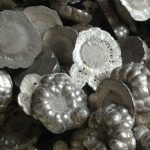Notice: Undefined index: sith_hide_share in /www/sites/alloy.wiki/index/wp-content/themes/likegoogle/single.php on line 32
Deprecated: get_settings is deprecated since version 2.1.0! Use get_option() instead. in /www/sites/alloy.wiki/index/wp-includes/functions.php on line 4862
Titanium is a very corrosion-resistant metal. The thermodynamic data of the titanium bar indicate that titanium is a metal with very unstable thermodynamics. If titanium can be dissolved to form Ti2+, its standard electrode has a large negative potential (-1.63v) and its surface is always covered with a dull oxide film. In this way, the stable potential of titanium is stably inclined to positive value. For example, the stable potential of titanium in sea water at 25℃ is about + 0.09v. Standard electrode potentials corresponding to a series of titanium electrode reactions can be obtained in chemistry manuals and textbooks. It is worth pointing out that in practice these data are not directly measured, but are often calculated from thermodynamic data, and because of different data sources, it is not surprising that several different electrode reactions may be represented at the same time.

The electrode potential data of the electrode reaction of titanium indicate that its surface is very active and is usually covered with a naturally occurring oxide film in the air. Excellent corrosion resistance of titanium, therefore, is the result of titanium surface there's always a layer of stable, strong adhesion, good special protective oxide film, is actually a layer of titanium oxide film stability determines the nature of corrosion resistance, including titanium and titanium alloy titanium rod, titanium wire, titanium plate, etc all have strong corrosion resistance, various grades of corrosion resistance is different, of course, we talk about in the content of the web site before, not said today. Theoretically, the P/B ratio of a protective oxide film must be greater than 1. If it is less than 1, the oxide film cannot completely cover the metal surface, so it is impossible to protect. If this ratio is too large, then the compressive stress in the oxide film increases accordingly, which is easy to cause the rupture of the oxide film, but also has no protective effect. The P/B ratio of titanium varies from 1 to 2.5 depending on the composition and structure of the oxide film. From this basic analysis, the oxide film of titanium can have better protection performance.
When the surface of titanium is exposed to the atmosphere or water solution, a new oxide film will be automatically generated immediately. For example, the thickness of the oxide film in the atmosphere at room temperature is 1.2~1.6nm, and thickens with time. The thickness naturally increases to 5nm after 70 days, and gradually increases to 8~9nm after 545 days. Artificially enhanced oxidation conditions (such as heating, using oxidants or anodic oxidation) can accelerate the growth of surface oxidation film and obtain a relatively thick oxide film, thus improving the corrosion resistance of titanium. Therefore, the oxidation film generated by anodic oxidation and thermal oxidation can obviously improve the corrosion resistance of titanium. Now our customers have made a lot of similar products with our titanium rod titanium wire, showing that this is the way to go.
The oxide film of titanium bars (including thermal oxide film or anodic oxide film) is not a single structure, and the composition and structure of the oxide vary with the formation conditions. In general, the interface between the oxide film and the environment may be TiO2, while TiO may be dominant in the interface between the oxide film and the metal. That is to say, the most surface of the titanium rod we produced is TiO2 under general conditions, and TiO is at the interface between metal and oxide film. The titanium wire, the titanium sheet, the titanium forgings are all the same, and the surface of the titanium alloy rod is more complicated. However, whether it is pure titanium rod or titanium alloy rod, titanium alloy wire in the middle there are different valence transition layer, or even non-chemical equivalent oxide, which means that the oxide film of titanium material has a multilayer structure. The formation of this oxide film cannot be simply interpreted as a direct reaction between titanium and oxygen (or oxygen in the air). Various mechanisms have been proposed by many researchers, with former Soviet union workers suggesting that the hydride is first formed and then forms a blunt oxide film on top of the hydride.
Guest contributors are welcome at the Alloy Wiki.It is a weekly wiki and guide on alloy information and processing technology, while also about the vast array of opportunities that are present in manufacturing. Our team of writers consists of a Machining Material Supplier / Machinist / Tool and Die Maker, a Biomedical Engineer / Product Development Engineer, a Job Development Coordinator / Adjunct Professor, and a President and CEO of a manufacturing facility.
Link to this article:The chemical properties of titanium bars and wires
Reprint Statement: If there are no special instructions, all articles on this site are original. Please indicate the source for reprinting:Alloy Wiki,thanks!^^


